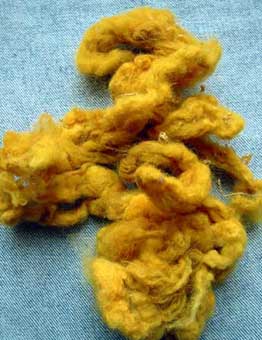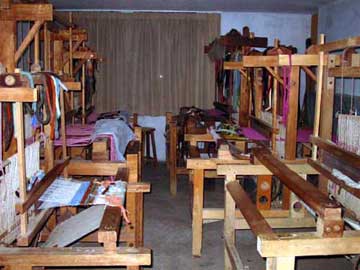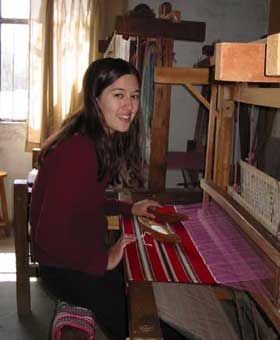|
|
|
|
. The
sheep’s wool is washed, preferable in the river
(Washing wool
in the Cunas River)
2. The wool
is then prepared for dying; this is pre-fixer, so that the colour will be
absorbed into the wool with double sulfate of aluminium and potassium, or with
iron sulfate. With double sulfate of aluminium and potassium, the ratio is
180 grams per kilo of wool and boil for 50 minutes. With iron sulfate, use 60
to 70 grams per kilo of wool and boil for 50 minutes.
|
 |
|

COMBING THE WOOL |
Plant dyes
Chilca:
2.5 kilos per kilo of prepared wool
Note: 1.
When the wool is prepared with double sulfate of aluminium and potassium and
chilca, boil for one hour
= yellow.
2. When the
wool is prepared with iron sulfate and chilca, boil for one hour = green.
|
|
|
Geulaysho,
lashta lashta (Lichen)
This lichen
has its own acid and therefore does not need to be used with a fixer such as
iron sulfate, etc. However, it can be mixed with a fixer to create different
colours. For brown, use this lichen with iron sulfate and for yellow, with
double sulfate of aluminium and potassium. This lichen can be used to dye the
wool a range of different browns and yellows.
Aged
lichen is used to dye the wool darker colours, deep yellows and browns, and
new lichen for lighter yellows. For the darkest brown, the wool is dyed with
aged lichen at midnight on a full moon. This technique was described to
Leoncio Tinoco by his grandmother as a teenager. At the time, he did not
believe her, but his studies later in life uncovered the same method. Science
has not been able to explain why the full moon should have such an impact on
the colour obtained, but that does not alter the truth of it
|
 |
|
 |
Cochineal
These
insects, found living in cacti, can be used when dead and ground. Use 150 to
200 grams of cochineal per kilo of wool. When used with wool fixed with double
sulfate of aluminium and potassium, cochineal will dye the wool from bright
red to baby pink, this last using the bath. When cream of tartar is mixed
with the cochineal, the wool is dyed an intense red.
I use only
plants which are inedible for both humans and animals. I believe that this is
the best way to avoid spoiling our environment.
|
|
|
Once the wool
has been dyed all the required colours, the wool must be carded and prepared
for weaving. The Relleno technique involves rolling the wool out across the
knee by hand, whilst pulling it out to its furthest length. The ‘thread’ is
then rolled under a plank of wood, so that it ends up looking almost like a
dreadlock. This technique is used to create the ‘picture-weavings’ of Leoncio
Tinoco. |
 |
|
|
Finally,
natural dyes operate in the three realms of the natural world: animal, mineral
and vegetal. It is always interesting to see how a plant can dye wool
different colours. This process can be very exciting and moving for both young
people and adults. | |







